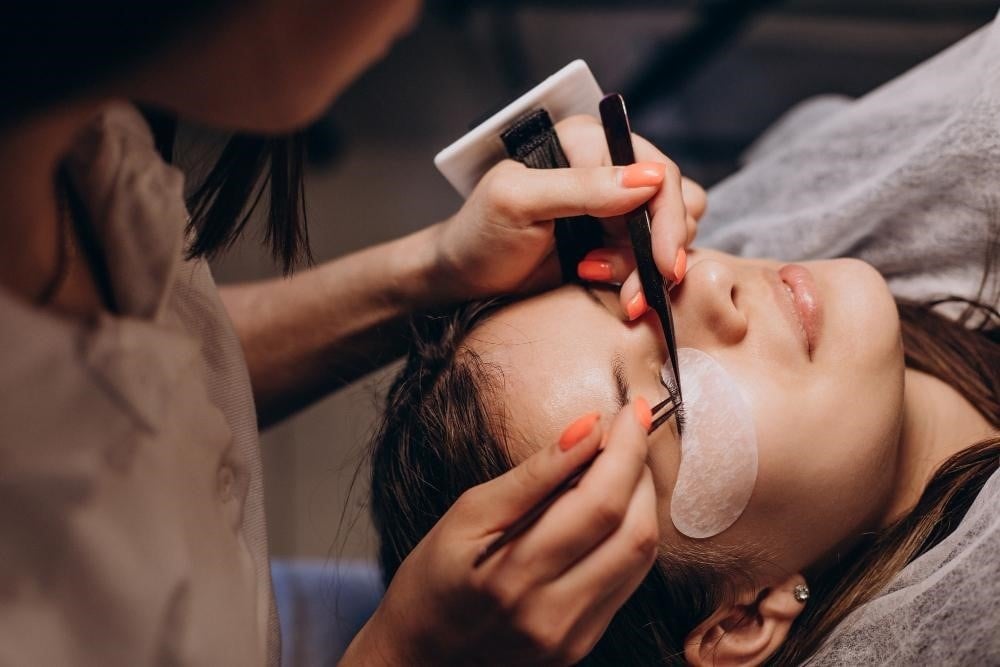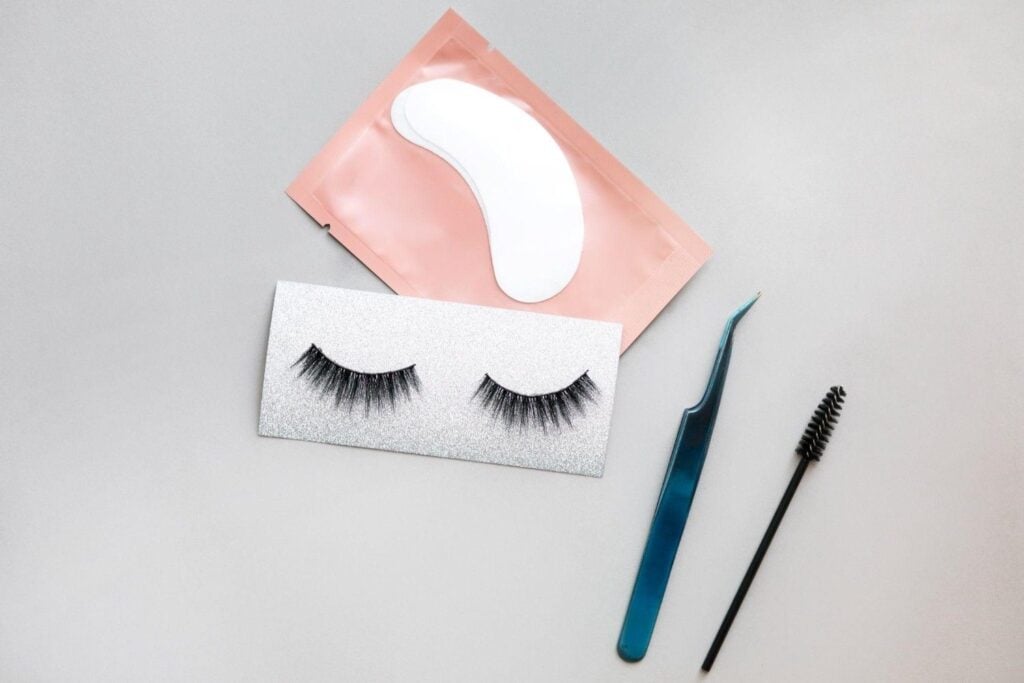Lash extensions have become one of those services where clients expect you to just know what you’re doing. They come in with Instagram photos of perfect, fluffy lashes and assume it’s simple. What they don’t see is the hours of practice it takes to isolate individual lashes without gluing them together, or the skill required to choose the right curl and length for someone’s specific eye shape. So let’s talk about what you actually need to understand if you’re serious about this skill.

Why Everyone Wants to Learn Lashes
Lash extensions are everywhere right now. Walk into any salon and you’ll see at least one person offering them. A lot of our prospective students mention lashes specifically when they tour our schools—they want to learn because they know the demand is there.
And they’re right. Clients love lash extensions because they wake up with makeup already on. They don’t have to mess with mascara. They look put-together even when they’re exhausted. For people with sparse or short natural lashes, extensions can be genuinely life-changing.
At Cosmetology & Spa Academy, here’s what we tell students upfront: lashes are precision work. You’re attaching synthetic fibers to individual natural lashes that are sometimes barely visible. You’re working inches from someone’s eyeball with adhesive that can sting if it gets in the wrong place. You’re creating a look that needs to last weeks without damaging the client’s natural lashes in the process.
It’s not the kind of thing you learn in a weekend certification course, no matter what some programs claim. Real competency takes practice, supervision, and honestly, some failures along the way.
The Materials Question: What Are You Actually Working With?
When students first start learning, they want to know which types of lash extensions are “the best.” And the answer is frustrating because it depends entirely on what you’re trying to achieve and who you’re working on.
Synthetic Lashes
Synthetic lashes are where most people start, and for good reason. They’re firm, they hold their curl, and they’re predictable. When you’re still building your isolation skills and trying not to glue three natural lashes together accidentally, predictable is your friend. They’re also glossy, which gives you that dramatic, obvious lash look. Some clients love that. Others think it looks too fake.
Silk lashes
Silk lashes are softer and lighter. They still have some structure, but they’re more flexible than synthetic. We see a lot of students gravitating toward silk once they’re comfortable with basics because it hits this middle ground between dramatic and natural. Clients who want noticeable lashes but don’t want it to look like they’re wearing falsies usually end up with silk.
Mink lashes
Then there’s mink, which is this whole conversation on its own. Real mink is incredibly soft and fluffy—it’s the closest thing to natural human lashes. It also costs more and requires more careful handling because it’s delicate. Some brands now offer synthetic mink alternatives that mimic the texture without using actual animal fur, which has become popular as more clients ask about sourcing.
The thing is, you can’t really understand the difference between eyelash extensions lash types until you’ve worked with all of them. Reading descriptions doesn’t cut it. You need to feel how synthetic picks up differently on your tweezers compared to silk.
You need to see how mink bonds with adhesive. That’s why our training includes working with multiple lash extension types, not just learning one material and calling it done.

Curl Types and Why They Matter More Than You’d Think
Here’s where new students often get overwhelmed: the curl alphabet. J, B, C, D, L, L+, and depending on which brand you’re using, sometimes more variations beyond that.
J-curl lash extensions
J-curl is barely curved at all. Honestly, we don’t use it that often because most clients come in wanting some lift and drama, and J-curl doesn’t deliver that. But occasionally you’ll have a client who just wants length with minimal curl, and that’s when J-curl makes sense.
B-curl lash extensions
B-curl has a soft curve. It’s subtle, natural-looking, appropriate for professional environments where dramatic lashes would feel out of place. We teach it because students need to know it exists, but in practice, most clients skip right past B-curl and ask for something more noticeable.
C-curl lash extensions
C-curl is the workhorse. If you’re ever unsure, C-curl is usually a safe bet. It gives you that lifted, awake look without being so dramatic that it overwhelms someone’s face. Probably 60-70% of the lash sets we see students doing end up being primarily C-curl.
D-curl lash extensions
D-curl is where you get into dramatic territory. Big lift, very noticeable, the kind of curl that photographs well and makes people ask “where did you get your lashes done?” Some students love working with D-curl because the results are so obvious. Others find it tricky because if you place it wrong or use it on the wrong eye shape, it can look strange.
L-curl and L+ lash extensions
Then you’ve got L-curl and L+, which have a flat base and then a sharp upward curve. These are specifically designed for clients with hooded eyes or lashes that grow downward. The flat base sits against the lid properly, and the sharp curve lifts everything up where it’s visible.
One of our instructors is obsessed with L-curl for hooded eyes. She’s converted a lot of students who initially didn’t understand why you’d need a specialty curl.
The real skill isn’t memorizing these curls. It’s knowing when to use which one, and when to mix them. Some of the best lash sets we see are combinations—maybe C-curl on the majority of the lashes but D-curl on the outer corners to create that lifted cat-eye effect.
But you don’t learn that from a chart. You learn it by doing it wrong a few times and figuring out what lash extensions curl types look better.

Classic, Volume, Hybrid: What These Terms Actually Mean
Students come in having seen these terms on salon menus, but they’re not always clear on what the actual difference is.
Classic lashes
Classic lashes mean one extension per natural lash. You’re isolating a single natural lash and attaching a single extension to it. The result is length and definition, but not a ton of added volume.
Classic sets work great for clients who have decent natural lash density and just want enhancement. They’re also where beginners start because the technique is more straightforward—you’re not trying to juggle multiple extensions at once.
Volume lashes
Volume lashes mean you’re applying multiple extensions to each natural lash. Could be two (which we call 2D), could be three (3D), could be six or more for mega-volume sets. These extensions are much thinner and lighter than classic lashes because you’re stacking them, and if you used thick extensions you’d weigh down the natural lash and cause damage.
Volume is harder. You’re creating fans of multiple lashes, either by hand or with pre-made fans, and your placement has to be precise or the whole thing looks messy. But the results can be stunning—really full, fluffy lashes that still somehow look soft and dimensional instead of clumpy.
Hybrid lashes
Hybrid is a mix of both. You’re doing some classic lashes and some volume fans in the same set. This gives you texture and dimension. It’s also a nice middle option for clients who think classic looks too subtle but volume looks too much.
We see a lot of students defaulting to hybrid once they’re comfortable with both techniques because it gives you flexibility to customize as you go.

The Learning Curve Nobody Warns You About
We’re going to be honest about what learning lash extensions actually looks like, because we don’t want students showing up expecting this to be easy.
First, your hands will hurt. You’re holding tweezers in a precision grip for extended periods, and if you’re not used to that, your hands and wrists will cramp. It gets better as you build stamina, but those first few weeks are genuinely uncomfortable.
Second, you will glue lashes together that shouldn’t be glued together. Everyone does it. You’re trying to isolate one natural lash, you think you’ve got it, you apply the extension, and then you realize you’ve accidentally bonded it to the neighboring lash.
When that happens, you have to carefully remove it with remover, which takes time and can be frustrating when you’re trying to work efficiently.
Third, your first few full sets are going to take forever. We’ve had students spend four hours on a full classic set when they’re just starting. That’s not sustainable as a business model—you can’t charge appropriately for four hours of work on a basic lash service.
But speed comes with repetition. By the time students graduate, most can complete a classic set in 90 minutes to two hours, which is more than reasonable.
And finally, you’re going to have at least one set that just looks bad. Maybe the lengths are uneven. Maybe the curl looks weird on that particular client. Maybe your isolation wasn’t great and there’s some clumping. It happens, and it’s mortifying, but it’s also how you learn.
Our instructors are there to help students fix mistakes and understand what went wrong so it doesn’t happen with the next client!
What Client Consultations Actually Look Like
Here’s something that doesn’t get enough emphasis in a lot of lash training: the consultation is as important as the application.
Before we let students touch a client’s lashes, they need to assess what they’re working with. What’s the condition of the natural lashes? Are they strong and healthy, or are they damaged and sparse? What direction do they grow? Are they straight, do they point downward, do they have natural curl?
Then there’s the eye shape conversation. Someone with round, prominent eyes can handle big dramatic lashes. Someone with hooded eyes needs careful placement or the lashes will hit their brow bone.
Someone with deep-set eyes might need extra length to make the lashes visible. Students have to learn to really look at facial structure and not just default to whatever’s trendy on social media.
The lifestyle questions matter too. Is this client going to be careful with their lashes, or are they going to rub their eyes constantly and sleep on their face? Do they wear a lot of eye makeup that they’ll need to remove carefully? Do they swim regularly? All of this affects how long the lashes will last and what style will work best.
We also teach students to have honest conversations about expectations. If a client comes in with a photo of lashes that are clearly photoshopped or require natural lashes they simply don’t have, students need to be able to say “we can’t achieve that exact look, but here’s what we can do.” Managing expectations upfront prevents unhappy clients later.

The Tools and Products Side of Things
You can’t do lash extensions without the right tools, and quality matters more than students usually expect.
Tweezers are everything. You need at least two pairs—one for isolating the natural lash and one for picking up and placing the extension. The tips need to be perfectly aligned, the grip needs to be comfortable, and the tension needs to be appropriate for the technique you’re using.
Cheap tweezers are genuinely harder to work with, and we’ve seen students struggle unnecessarily because they’re trying to save money on tools.
Adhesive is the other critical component. There are different dry times, different viscosities, different formulations for different humidity levels. Medical-grade adhesive is non-negotiable—we’re working near people’s eyes, and safety has to come first.
Students learn how to work with adhesive properly, including how much to use (less than you think), how often to refresh your adhesive drop (every 15-20 minutes) and how to troubleshoot if lashes aren’t adhering properly.
Then there are all the smaller supplies: under-eye gel pads to protect the lower lashes and skin, medical tape for taping back lids if needed, primer to clean natural lashes before application, nano misters to cure the adhesive, brushes to separate and fluff the lashes when you’re done.
We provide all of this during training so students can learn on professional-quality supplies.
When Things Go Wrong: Removal and Damage Control
Part of responsible lash training is teaching students what to do when lashes need to come off, either because the client wants them removed or because something went wrong.
Proper removal requires cream or gel remover that breaks down the adhesive bond. You can’t just pull lashes off—that rips out natural lashes and causes damage. Students practice removal just like they practice application, because it’s a skill in itself to dissolve the adhesive thoroughly without getting remover in the client’s eyes.
We also spend time on damage prevention and assessment. What does an overloaded natural lash look like? How do you know when lashes are too damaged to support extensions and the client needs a break? What do you do if a client comes in with an infection or irritation? These aren’t fun topics, but they’re essential for working safely.
One thing we emphasize heavily: if you don’t know what to do in a situation, you ask. You don’t guess. You don’t try to push through. You bring in someone more experienced. We’d rather have a student pause an appointment and ask for help than have them cause damage because they were too embarrassed to admit they weren’t sure.
Beyond the Basics: Where Lash Skills Can Take You
Once students have the fundamentals down, there are a lot of directions they can go with lash specialization.
Some students get really into volume work and want to learn Russian volume or mega-volume techniques. These involve creating fans with 10+ lashes that are incredibly thin and light. It’s advanced work, but clients pay premium prices for it.
Others get interested in color lashes—adding pops of color into lash sets for clients who want something unique. Or lash mapping, which is the technique of planning out exactly which lengths and curls go where for a perfectly customized set.
There’s also the business side. Some of our graduates focus exclusively on lashes and build entire businesses around it. They work faster than general cosmetologists because they’re doing lashes all day every day. They charge accordingly. They book out weeks in advance.
Lash lifts and tints are related services that don’t require extension application but still enhance natural lashes. Some students prefer these because they’re faster and there’s less risk of damage from long-term extension wear.
We offer continuing education and workshops for graduates who want to keep advancing their skills and learn about different types of lash extensions. The industry changes—new techniques come out, new products hit the market, trends shift. Staying current matters if you want to stay competitive.
👉 Explore our cosmetology program and learn more about our training!
Real Questions We Get About Lash Training
Can I learn lashes if I have shaky hands?
Yes, but it takes more practice. We’ve had students who were initially shaky develop steady hands through repetition and proper technique. Bracing your hands correctly helps a lot.
How long does it take to get fast at lash applications?
Most students can do a classic set in under two hours by the time they graduate. Getting it down to 90 minutes or less usually takes a few months of working professionally.
What if I accidentally poke someone in the eye?
It happens occasionally, especially when you’re learning. That’s why we emphasize client positioning, hand stabilization, and working carefully. Clients keep their eyes closed during application, which helps.
Do I need to buy my own lash supplies for training?
No, we provide everything during the program. You’d need your own kit if you’re working professionally after graduation.
Are there clients who can’t get lash extensions?
Yes. People with certain eye infections, very weak natural lashes, or specific allergies to adhesive aren’t good candidates. That’s part of what we teach—how to assess whether someone should get lashes.
Can I make a living doing only lashes?
Some people do, especially in busy markets. But most cosmetologists offer lashes as one service among several. Having multiple revenue streams is usually smarter.
















